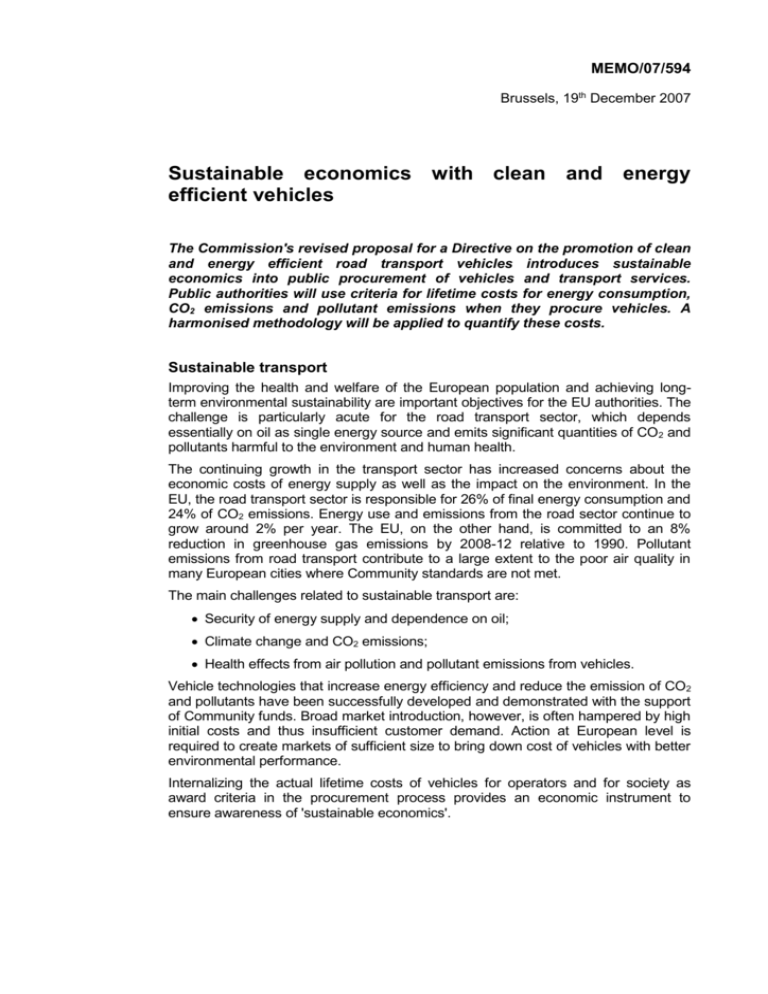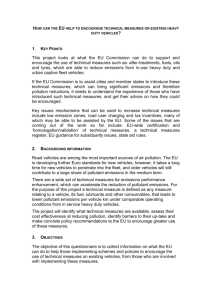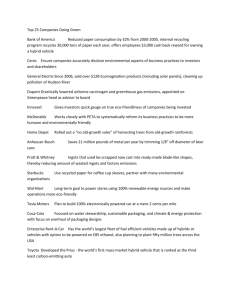DOC
advertisement

MEMO/07/594 Brussels, 19th December 2007 Sustainable economics with clean and energy efficient vehicles The Commission's revised proposal for a Directive on the promotion of clean and energy efficient road transport vehicles introduces sustainable economics into public procurement of vehicles and transport services. Public authorities will use criteria for lifetime costs for energy consumption, CO2 emissions and pollutant emissions when they procure vehicles. A harmonised methodology will be applied to quantify these costs. Sustainable transport Improving the health and welfare of the European population and achieving longterm environmental sustainability are important objectives for the EU authorities. The challenge is particularly acute for the road transport sector, which depends essentially on oil as single energy source and emits significant quantities of CO2 and pollutants harmful to the environment and human health. The continuing growth in the transport sector has increased concerns about the economic costs of energy supply as well as the impact on the environment. In the EU, the road transport sector is responsible for 26% of final energy consumption and 24% of CO2 emissions. Energy use and emissions from the road sector continue to grow around 2% per year. The EU, on the other hand, is committed to an 8% reduction in greenhouse gas emissions by 2008-12 relative to 1990. Pollutant emissions from road transport contribute to a large extent to the poor air quality in many European cities where Community standards are not met. The main challenges related to sustainable transport are: Security of energy supply and dependence on oil; Climate change and CO2 emissions; Health effects from air pollution and pollutant emissions from vehicles. Vehicle technologies that increase energy efficiency and reduce the emission of CO2 and pollutants have been successfully developed and demonstrated with the support of Community funds. Broad market introduction, however, is often hampered by high initial costs and thus insufficient customer demand. Action at European level is required to create markets of sufficient size to bring down cost of vehicles with better environmental performance. Internalizing the actual lifetime costs of vehicles for operators and for society as award criteria in the procurement process provides an economic instrument to ensure awareness of 'sustainable economics'. Lifetime costs for vehicle operation The key parts of energy and environmental costs are the costs of fuel consumption and emissions of carbon dioxide (CO2) and pollutants with an impact on health, such as nitrous oxides (NOx), non-methane hydrocarbons (NMHC) and particulate matter (PM). Studies on the negative effects of traffic emissions have provided reference values per unit of pollutant emitted. Such values vary in relation with territorial context. Average values at EU level have been estimated in particular by the BeTa1, ExternE2, UNITE3 and CAFÉ4 studies, which were widely reviewed by experts. Cost for CO2 emissions has been determined e.g. in the UNITE and ExternE projects which both come very close in their estimations. Examples of total lifetime costs, together with typical vehicle prices, are given in Table 1 for vehicles with present emission standards, a EURO IV bus, and a EURO 4 diesel car. This monetisation shows the relative importance of costs incurred over the lifetime of vehicles, compared with the vehicle price invested into procurement. An informed decision, taking into account the total cost of the vehicle's purchase price, the energy cost for the operator and pollutant costs for society could then be based on the sum of vehicle price and lifetime costs. This would minimise the overall cost for the operator and for society. Table 1: Lifetime costs and vehicle prices (indicative example for illustrative purposes only) Vehicle type Bus (1 million km) Diesel car (200.000 km) Petrol car (200.000 km) Vehicle price NMHC PM Vehicle price + lifetime costs Life-time cost for Fuel CO2 NOx 150.000 € 313.500 € 30.210 € 87.780 € 2.622 € 9.918 € 594.030 € 17.000 € 5.500 € 530 € 220 € 10 € 435 € 23.695 € 15.000 € 7.700 € 669 € 70 € 20 € 87 € 23.547 € Environmental gains with lifetime cost based procurement The potential for energy saving and emissions reduction from clean and energy efficient vehicles through promotion by public procurement has been estimated in a study by PriceWaterhouseCoopers (PWC)5 for the Commission by assuming all decisions would be based on the sum of vehicle price and lifetime costs. An energy saving of 22% of the vehicles covered could be achieved, resulting in a total amount of 4.6 Terawatt-hours annually by 2017, by when the maximum effect from this measure could be expected. This saving corresponds to about half the annual energy production of a large nuclear power station. CO2 emissions from the vehicles covered by public procurement could be reduced by 29% by 2017, giving a total of 1.9 Mega-tonnes CO2 avoided annually. This represents of order 0.5 % of all transport CO2 emissions. 1 2 3 4 P. Watkiss, M. Holland, “Estimates of the Marginal External Costs of Air Pollution in Europe”, Didcot, 2002. P. Bickel, R. Friedrich, ExternE, Methodology 2005 update, European Commission, Luxembourg, 2005 P. Bickel, S. Schmid, al., Unification of accounts and marginal costs for Transport Efficiency, Stuttgart, 2003. M. Holland, et al., CAFÉ 2005a, AEA Technology, Didcot, 2005 2 Economic gains with lifetime cost based procurement A cost-benefit analysis in the PWC study, weighing possible higher investment cost for the vehicles up-front against the saving from lower energy consumption and CO2 and pollutant emissions, shows potentially large economic gains for operators as well as for society. Potentially higher cost for the vehicles is largely compensated already by the saving from lower fuel cost, which profits the operator directly. For the period up to 2017, possibly higher expenditures of 11.5 billion Euro would be overcompensated by a saving of 21.3 billion Euro from a lower energy bill. Additional benefits of 2.5 billion Euro saving can be expected due to lower CO2 emissions, and 9.4 billion Euro saving due to lower pollutant emissions. The total net benefit over the period up to 2017 could amount to 21.5 billion Euro. For more information: http://ec.europa.eu/transport/clean/index_en.htm http://ec.europa.eu/transport/clean/promotion/index_en.htm IP/07/1962 5 http://ec.europa.eu/transport/clean/index_en.htm 3







